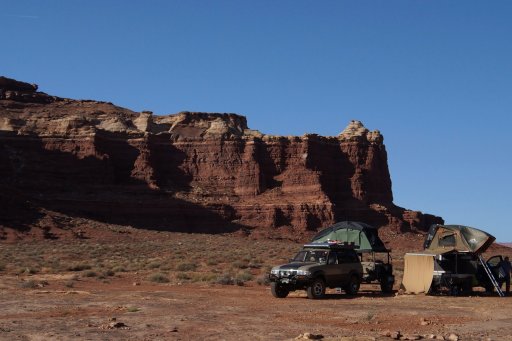So I know this question has thousands of answers and depends on individual experience but I’m still curious. When route planning, what is your typically daily distance for non paved road travel?
Daily Distance
- Thread starter ZR2Infinity&Beyond
- Start date
-
Guest, UPDATE We went through the site migration runbook and completed all steps. We will need to complete the migration next week, but will leave the forums up for the weekend. A few days after maintenance, a major upgrade revision to the forum site will occur.

Explorer I
No typical distance because non paved roads vary so much.

Advocate III
- 5,584
- First Name
- Michael
- Last Name
- Rose
- Member #
-
20990
- Ham/GMRS Callsign
- W7FSB
- Service Branch
- US ARMY Retired
I know this isn’t what you want to hear… but it depends…I have gone 4 miles in one day, and I’ve gone 1,000 miles in day… road conditions can (and are) ever changing in the back country. It’s easier to plan by time then by milage… if you can only go 5mph, it’s going to take you 20 hours to go 100 miles.So I know this question has thousands of answers and depends on individual experience but I’m still curious. When route planning, what is your typically daily distance for non paved road travel?
I knew I would get a lot of “depends” type of answers so no need to apologize. Still curious on how every one plans and what they take into consideration.I know this isn’t what you want to hear… but it depends…I have gone 4 miles in one day, and I’ve gone 1,000 miles in day… road conditions can (and are) ever changing in the back country. It’s easier to plan by time then by milage… if you can only go 5mph, it’s going to take you 20 hours to go 100 miles.So I know this question has thousands of answers and depends on individual experience but I’m still curious. When route planning, what is your typically daily distance for non paved road travel?

Advocate III
- 5,584
- First Name
- Michael
- Last Name
- Rose
- Member #
-
20990
- Ham/GMRS Callsign
- W7FSB
- Service Branch
- US ARMY Retired
Look at the terrain features of the map….. if the road is pretty much flat and a major road structure you can go several hundred miles.. if the road has lots of ups and downs, high elevation gains (and losses) a minor road system, you might get 20 miles… also experience comes into play… my favorite day trip road takes me 3 hours to drive 50 miles… where as a novice takes 2 days to cover the same road because of the difficulty or the road… now since I can do the road in 3 hours, does that mean I’m speeding… no, it just means I know the lines to take to get me through the obstacles safely, I know where the mud hole is the deepest and how to avoid it, I know where the ledge is at that I have to drop a tire into so I won’t get high centered going over the boulder… but looking at the map, the road looks like a steep climb for 5 miles and flattens out to run the ridge for the reminder 45 miles with out any water crossings or rock climbing. So a novice new to tue area would budget 1.5 to 2 hours for the leg of the trip, not 3, and definitely not 2 days.I knew I would get a lot of “depends” type of answers so no need to apologize. Still curious on how every one plans and what they take into consideration.
So when I plan a long distance trip, I budget by days, especially if I’m making my own route and not a well documented trail system. I pick a destination and give myself say a week to get there.. if I make the destination sooner, great I have more time to explore at the destination or better yet pick another one with bail out points a long the way. If I don’t make it to my destination within my time line, ohh we’ll bail out and pick up where I left off last time.
I appreciate the depth in your response! Great things to consider.Look at the terrain features of the map….. if the road is pretty much flat and a major road structure you can go several hundred miles.. if the road has lots of ups and downs, high elevation gains (and losses) a minor road system, you might get 20 miles… also experience comes into play… my favorite day trip road takes me 3 hours to drive 50 miles… where as a novice takes 2 days to cover the same road because of the difficulty or the road… now since I can do the road in 3 hours, does that mean I’m speeding… no, it just means I know the lines to take to get me through the obstacles safely, I know where the mud hole is the deepest and how to avoid it, I know where the ledge is at that I have to drop a tire into so I won’t get high centered going over the boulder… but looking at the map, the road looks like a steep climb for 5 miles and flattens out to run the ridge for the reminder 45 miles with out any water crossings or rock climbing. So a novice new to tue area would budget 1.5 to 2 hours for the leg of the trip, not 3, and definitely not 2 days.I knew I would get a lot of “depends” type of answers so no need to apologize. Still curious on how every one plans and what they take into consideration.
So when I plan a long distance trip, I budget by days, especially if I’m making my own route and not a well documented trail system. I pick a destination and give myself say a week to get there.. if I make the destination sooner, great I have more time to explore at the destination or better yet pick another one with bail out points a long the way. If I don’t make it to my destination within my time line, ohh we’ll bail out and pick up where I left off last time.

Member III
Right along with what @M Rose said. My planning is more camp site to camp site. If I've never been there, I tend to place the camp sites closer if I know where to camp. If I don't know where to camp, I start looking for a place around 3pm. Then I have the "I need to be leaving the area on this day". On those I have either run out of things to see and got to the end early or had to exit because I ran out of time.
Next issue you have is, how many vehicles. The more, the slower.
Over all, I try to make camp with at least 2 hours before dusk (doesn't always happen). If that means I drive past a spot I thought I was stopping or searching out something because I went slower then I thought.
I use to run the Dusy trail every year. 32 miles, 10 miles a day is average. I could knock out a day in about 6 hours. I normally spend a week, camping in place for 2-3 days in one spot. I brought a guy one year where it was all I could do to make 5 miles a day. we just made more camps.
Next issue you have is, how many vehicles. The more, the slower.
Over all, I try to make camp with at least 2 hours before dusk (doesn't always happen). If that means I drive past a spot I thought I was stopping or searching out something because I went slower then I thought.
I use to run the Dusy trail every year. 32 miles, 10 miles a day is average. I could knock out a day in about 6 hours. I normally spend a week, camping in place for 2-3 days in one spot. I brought a guy one year where it was all I could do to make 5 miles a day. we just made more camps.
"non-paved road" can mean a wide range of conditions....non paved road travel?
- The GRR is 700 km of gravel/dirt (a lot more if you explore the canyons) and we spent 9 days to travel this route.
- The Dempster is about the same distance, and we've driven this in 4 days.
- From Sipi Falls to Suam border post is 91 km and it took us 4 days (with a detour for the terrible conditions).
The use of the term "road" implies something different from a "track". All of these examples are "roads"; tracks are another story.

Explorer I
What is the difference? I assume a road is anything from pavement/asphalt to gravel to hard dirt - all fairly well traveled. And a track is something you would find in a more remote area that sees far fewer vehicles and is typically in far rougher condition? Interested to know more!The use of the term "road" implies something different from a "track". All of these examples are "roads"; tracks are another story.

Traveler II
I usually plan 100-150 miles per day on forest service roads that you would typically find in Colorado or along a track like the Continental Divide Trail. This seems to work well for a 9AM departure from camp and a 4-5PM arrival at camp. Sure some days I cover that mileage faster and other days it's slower. The only time this practice has failed me was not being able to locate a place to camp where I intended.

Advocate I
Funny you should mention that. I have two young ones. I want them to be involved as much as possible and explore the outdoors with me, even if that means exploring for 30 seconds for a “potty” break lol.Got kids? Add more stopped time.

Off-Road Ranger I
- 3,507
- First Name
- Mike
- Last Name
- Roots
- Member #
-
16968
- Ham/GMRS Callsign
- GMRS: WSGB862
- Service Branch
- USAF

Member III
For me, "Track" was short for "Two Track". Literally two tracks across the ground. With enough travel, a two track widens enough to become almost a road. I've followed tracks that couldn't have had more than a couple of vehicles making them. Years later the "Two Track" route became more popular and now its a wider track. That is when I start calling them a road. There's a couple of spots off the Mojave Road that I drove decades ago as a barely defined two track. Today their single lane roads.What is the difference? I assume a road is anything from pavement/asphalt to gravel to hard dirt - all fairly well traveled. And a track is something you would find in a more remote area that sees far fewer vehicles and is typically in far rougher condition? Interested to know more!
Also for me a "Trail" is a "Single Track". Trail's out here are normally motorcycle tracks. I have followed trails in my vehicle making them into two tracks. In Stoddard Valley, my friends and I followed a single track up a canyon years ago. We turned it into a two track over the years, later, someone named it and now its on a map called Pumpkin Eater. I guess now its a road?

Off-Road Ranger I
- 2,865
- First Name
- Donald
- Last Name
- Diehl
- Member #
-
0745
- Ham/GMRS Callsign
- WRPN 506
to the OPs question; . We used to cover 6 to 7 hundred miles per day heading west on blacktop roads. Now that I'm retired cut those numbers in half. Now we get off the interstates west of Missouri and take our time experiencing the great plains. We often joke that we are the High Plains Drifters. Once we get off the paved roads and into the back country we just go, slowly, until we stumble upon that perfect campsite, that we may or may not stay at for multiple days. Some days we might cover 5 or 6 hours of technical driving and only get 10 or 15 miles to the next campsite. One trip it took a full 12 hour day to traverse less than 100 miles to get to a pre-determined campsite. In short; Planning goes out the window once we leave the rat race behind, with a vague idea of when it is time to head home. Who was it that said "the best laid plans of mice and men oft go awry"? Well whomever it was (Steinbeck?) he was right. If you must, plan when to leave and plan when to get home, anything more easily spoils what might have been a great adventure.
Here is one of the worst campsites of our last trip. LOL!! It was windy, ( 40-50 mph) it was cold, it was dark, we pulled off the trail unto a large flat rock, set up quickly ate bag food, hunkered down and woke up to this the next morning.

Here is one of the worst campsites of our last trip. LOL!! It was windy, ( 40-50 mph) it was cold, it was dark, we pulled off the trail unto a large flat rock, set up quickly ate bag food, hunkered down and woke up to this the next morning.

Appreciate all the responses! Nothing mind blowing but all really good things to consider.
yes - that's more or less my meaning.What is the difference? I assume a road is anything from pavement/asphalt to gravel to hard dirt - all fairly well traveled. And a track is something you would find in a more remote area that sees far fewer vehicles and is typically in far rougher condition? Interested to know more!
A road allows travel at a reasonably consistent speed, which could be 50 km/h or 150 km/h; a track (in my view) necessitates adjusting speed to potholes, ruts, water, etc and means travel at anything from walking pace to 60 km/h or so. on roads you can cover 100 km in anything from a couple of hours to half of that (or less); a track could require days to cover 100 km.
Obviously a wild generalisation, and if you stop frequently times will change accordingly...

Explorer I
Thanks! Have heard my favorite Australian YouTubers use the term "track" a lot but it is not commonly used in the states. Thanks for the info!yes - that's more or less my meaning.
A road allows travel at a reasonably consistent speed, which could be 50 km/h or 150 km/h; a track (in my view) necessitates adjusting speed to potholes, ruts, water, etc and means travel at anything from walking pace to 60 km/h or so. on roads you can cover 100 km in anything from a couple of hours to half of that (or less); a track could require days to cover 100 km.
Obviously a wild generalisation, and if you stop frequently times will change accordingly...
Great reminder! Enjoy the journey.If you're covering more than 50 miles a day on a trail, you're not paying the trail enough attention.
View attachment 234459




